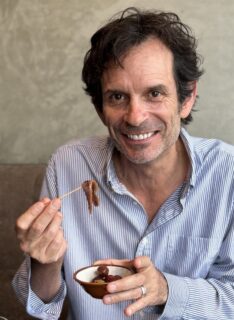
Podcast: Play in new window | Download (Duration: 23:34 — 21.7MB)
Subscribe: Google Podcasts | Spotify | Android | RSS | More
 The Spanish are the world’s greatest anchovy eaters. They get through about 2.69 kilograms each a year, more than a tin a week. So you might be forgiven for thinking that anchovies have always been a part of Spanish cuisine. Not so, with the exception of the good people of Malaga, who developed a thing for deep-fried fresh anchovies. The rest of Spain resolutely ignored anchovies as food, spreading them instead on their fields as fertiliser. All that started to change in the late 19th century, when Italians, expert in the ways of salting fish, fetched up on the Basque coast to buy up all the fish that nobody else wanted. Among them, Giovanni Vella, who invented the modern tin of anchovy fillets in olive oil.
The Spanish are the world’s greatest anchovy eaters. They get through about 2.69 kilograms each a year, more than a tin a week. So you might be forgiven for thinking that anchovies have always been a part of Spanish cuisine. Not so, with the exception of the good people of Malaga, who developed a thing for deep-fried fresh anchovies. The rest of Spain resolutely ignored anchovies as food, spreading them instead on their fields as fertiliser. All that started to change in the late 19th century, when Italians, expert in the ways of salting fish, fetched up on the Basque coast to buy up all the fish that nobody else wanted. Among them, Giovanni Vella, who invented the modern tin of anchovy fillets in olive oil.
It was, according to Chris Beckman, author of A Twist in the Tail: how the humble anchovy flavoured Western cuisine, a win for everyone.
Notes
- Christopher Beckman’s A Twist in the Tail: How the Humble Anchovy Flavoured Western Cuisine is published by Hurst & Co.
- If you haven’t already heard it, the previous episode celebrates the anchovy in modern Spain.
- Here’s the transcript. Also, from this episode, I am trying to make transcripts available in podcast players that offer this service. Let me know if you experience any difficulties.




 If only we could get over our squeamishness, insects can save the planet, banish hunger, protect the rainforests and reduce the climate catastrophe. At least, that’s what article after article tell us as they sing the praises of feeding our food waste to insects like the larvae of the black soldier fly. Insects can grow 5000-fold in 12 days, producing prodigious quantities of protein in less than 100th the space of soya beans.
If only we could get over our squeamishness, insects can save the planet, banish hunger, protect the rainforests and reduce the climate catastrophe. At least, that’s what article after article tell us as they sing the praises of feeding our food waste to insects like the larvae of the black soldier fly. Insects can grow 5000-fold in 12 days, producing prodigious quantities of protein in less than 100th the space of soya beans. 
